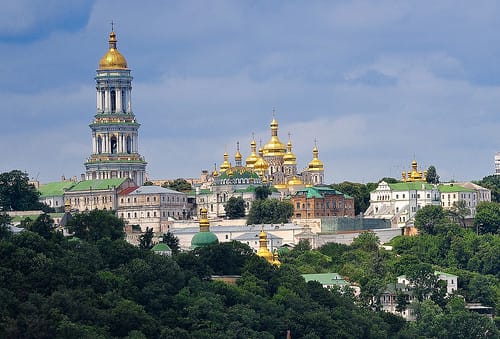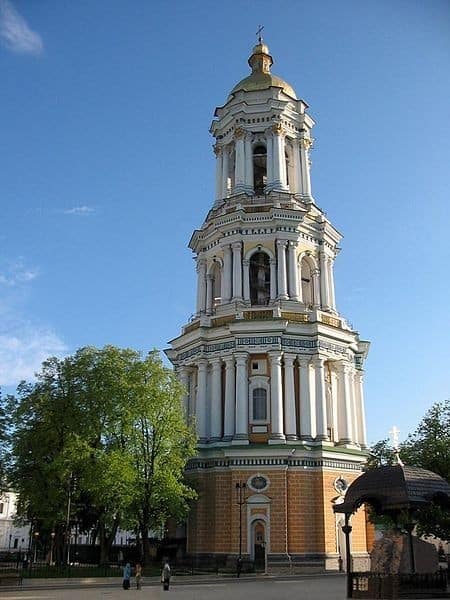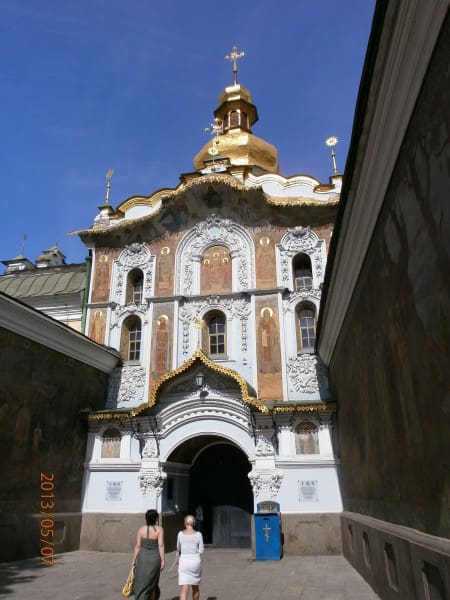
Kiev Pechersk Lavra or Kyiv Pechersk Lavra, also known as the Kiev Monastery of the Caves, is a historic Orthodox Christian monastery and has also given name to one of the city districts where it is located in Kiev.
Since its foundation as the cave monastery in 1051 the Lavra has been a preeminent center of the Eastern Orthodox Christianity in Eastern Europe. Together with the Saint Sophia Cathedral, it is inscribed as a UNESCO World Heritage Site. The monastery complex is considered a separate national historic-cultural preserve (sanctuary), the national status to which was granted on 13 March 1996. The Lavra also not only located in another part of the city, but is part of a different national sanctuary than Saint Sophia Cathedral. While being a cultural attraction, the monastery is currently active. It was named one of the Seven Wonders of Ukraine on 21 August 2007, based on voting by experts and the internet community.
Currently, the jurisdiction over the site is divided between the state museum, National Kiev-Pechersk Historic-Cultural Preserve, and the Ukrainian Orthodox Church (Moscow Patriarchy) as the site of the chief monastery of that Church and the residence of its leader,Metropolitan Volodymyr
The word pechera means cave. The word lavra is used to describe high-ranking male monasteries for monks of the Eastern Orthodox Church. Therefore the name of the monastery is also translated as Kiev Cave Monastery, Kiev Caves Monastery or the Kiev Monastery of the Caves.
According to the Primary Chronicle, in the early 11th century, Anthony, an Orthodox monk from Esphigmenon monastery on Mount Athos, originally from Liubech of the Principality of Chernihiv, returned to Rus’ and settled in Kiev as a missionary of monastic tradition to Kievan Rus’. He chose a cave at the Berestov Mount that overlooked the Dnieper River and a community of disciples soon grew. PrinceIziaslav I of Kiev ceded the whole mount to the Antonite monks who founded a monastery built by architects from Constantinople.
The main attractions of the Lavra include the Gate Church of the Trinity by the entrance, the Great Lavra Belltower, one of the most notable features of the Kiev skyline, and the Dormition Cathedral, destroyed in World War II, and fully reconstructed in recent years. Other churches and cathedrals of the Lavra include: the Refectory Church, the Church of All Saints, the Church of the Saviour at Berestove, the Church of the Exaltation of Cross, the Church of the Trinity, the Church of the Nativity of the Virgin, the Church of the Conception of St. Anne, and the Church of the Life-Giving Spring. The Lavra also contains many other constructions, including: the St. Nicholas Monastery and the Kiev Theological Academy and Seminary.
Great Lavra Belltower

The Great Lavra Belltower is one of the most notable features of the Kiev skyline and among the main attractions of the Lavra. 96.5 meters in height, it was the tallest free-standing belltower at the time of its construction in 1731–1745, and was designed by the architect Johann Gottfried Schädel. It is aClassical style construction and consists of tiers, surmounted by a gilded dome.
Gate Church of the Trinity

The Gate Church of the Trinity is located atop the Holy Gates, which houses the entrance to the monastery. According to a legend, this church was founded by the Chernihiv Prince Sviatoslav. It was built atop an ancient stone church which used to stand in its place. After the fire of 1718 the church was rebuilt, its revere facades and interior walls enriched with ornate . Stucco work made by master craftsman V. Stefaovych. In the 18th century a new gilded pear-shaped dome was built, the facade and exterior walls were decorated with stucco-moulded plant ornaments and a vestibule built of stone attached to the north end. In the early 20th century the fronts and the walls flanking the entrance were painted by icon painters under the guidance of V. Sonin. The interior of the Gate Trinity Church with murals by the early 18th century painter Alimpy Galik is of great artistic value.
The Pechersk Lavra is definitely one of the major attractions of Kiev, whether you adhere to the religiosity that buildt it or not, no trip to Kiev can be complete without a visit there.